Everyone by now must be familiar with the eyecatching biomes of the Eden Project. But how did it all start? One the project's founders, Philip McMillan Browse, recounted the story at the Christmas meeting of the Professional Horticultural Group South West and a summary of his talk is presented below. Members of the SCI Horticulture Group are welcome at all PHGSW meetings and the next one is on 14 February at the Cannington Centre, Bridgewater College when Dr Karen Girard of Koppert will describe the latest developments in the biocontrol of pests and diseases.
In the meantime, do not forget to book your place at our other forthcoming events:
- Medicinal Plants: From Crop to Cure? - 29 March
- Biofortified and Functional Food: A Healthy Future? - 19 May.
Editor
How the Eden Project evolved

The story began when Philip was working for Cornwall County Council and, out of the blue, was telephoned by Tim Smit and asked if he could look at a garden at Heligan and see if it was worth restoring. Searching through the jungle that the garden had become he found much of the original planting including many magnificent Hooker tree-Rhododendrons and declared the garden worth reclaiming. He then found himself appointed as its first Director.
No sooner was the course for Heligan set than grander schemes started to be thought about. However, it perhaps comes as no surprise that the original idea of Eden developed during a protracted debate between Philip, Tim Smit and Peter Thoday and involved the consumption of a couple of bottles of whisky.
They decided from the outset that it would have to be iconic - like the Taj Mahal etc. So their aim was to build the biggest greenhouse in the world. They did not want it to be a theme park but an institution - a botanic garden for 21st century. Avoiding damage to the environment by chemicals was chosen as a theme.

Unlike other Millennium projects, they did not even own a site on which to build their greenhouse. The area around St Austell was pockmarked with 'holes' left by the china clay industry although these were worth millions simply as holes into which landfill could be dumped. However, Lord Falmouth agreed to sell them one at the knock-down price of £3.8m.
The press took on Eden as a good project due largely to the inspiration of Tim Smit. He used two principles to achieve this:
- The Tinkerbell theory - if you believe hard enough that Eden is real it will be
- The Last Man Standing theory - keep going on and on being awkward until people give in.
Gradually the money was raised by donations and loans and the project came into being finally opening ten years ago in March 2001.
Philip paid particular emphasis on the goodwill of all concerned, many of whom worked simply in the hope that the project would come off and they would eventually be paid. In particular he paid tribute to Robert and Alfred McAlpine who not only undertook the project on a no profit basis but joined the Eden Board thus ensuring that the developers were part of the team and thus 'on side'.
The subsequent success of Eden is well documented although they have recently learned the disadvantage of living in a hole when it rains heavily. Key elements in that success were first bringing in people they knew or were recommended and then trusting them to get on with the job without endless committee meetings. Second they chose young people to work on site. If you want the impossible done, ask the young as they don't know it can't be done!
Plant of the Month
Eranthis hyemalis (winter aconite, Ranunculaceae)
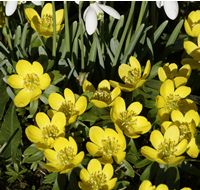
Like many members of the buttercup family, it contains a wealth of toxic compounds. It is commonly reported that winter aconites contain cardiac glycosides such as are found in hellebores but more recent studies have not found these substances. Instead they have isolated 4H-chromenone glycosides which also have cardiac activity. It is these studies and other similar ones that have shown that winter aconites are more closely related to Actaea and Cimicifuga than to Helleborus as previously thought.
The general structures of two of these compounds are shown below:


Winter aconites have also been used to study the detailed mechanism involved in the thermonastic movements of petals, sepals and tepals. Thermonastic movements are those that happen in response to the plant experiencing a temperature change. You may have noticed the opening of crocus and tulip flowers during the day 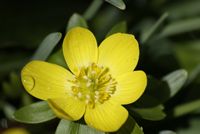
So as you marvel at the carpets of winter aconites you see this winter, spare a moment for the humble plant playing its own important role in furthering the understanding of plant development.
Medicinal Plant of the Month
Sambucus nigra (elderberry, Adoxaceae)
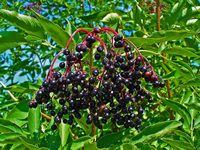
The elderberry is a deciduous shrub or small tree native to much of Europe. There are many culinary uses of the plant including making a cordial from the flowers, wine from flowers or berries and jam from the berries. It is extracts of the berries that are recommended for prevention and treatment of colds and flu. (Photo by H Zell)
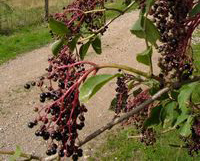
Finally, a study reported just last year on the anti-bacterial properties of elderberry. The researchers, working in Ireland, have shown inhibition of a range of different bacteria by organic and aqueous extracts of both flowers and berries.
And the good news is that its not just the extracts that contain all the potent molecules - elderberry wine works just as well!
Horticulture Industry News
For the very latest horticultural news follow us on Facebook and or
Twitter.
IPM benefits from global warming!
The 2011 IPM Essen exhibition went off successfully and for the first time since records began no snow fell during the show. 'Positively tropical' comments Stuart Booker who organises the UK group at the show on behalf of the Commercial Horticultural Association and UK Trade and Investment. Around 60,000 visitors went to the show to view the 1,500 stands from 47 countries which filled the exhibition halls of Messe Essen. Mark Taylor of Kernock Plants commented on Twitter, 'It is definitely the best International Trade Show (for plants) in the world. If the Americans say it, it must be true'.
Dupont buys Danisco
Danish food ingredient and enzyme company Danisco said it would be acquired by US chemical giant DuPont, pending approval by regulators. The acquisition of Danisco, a profitable leader in the agri-food and biotechnology sectors, is set to make DuPont 'a clear leader in industrial biotechnology,' the Wilmington, Delaware-based company said. Danisco is a leading technology-driven organisation, with outstanding research and application development capabilities. The company has specialty food ingredients that are used in the processing of fresh produce.
Sour note in sugar harvest
Thousands of acres of sugar beet are not fit to process because of severe cold weather. Some farmers, particularly those who supply the Newark plant of British Sugar with sugar beet, have been forced to plough in their beet as a result of the bad weather. In turn this will lead to less beet waste and since this is all used to create by-products, products like topsoil for landscaping could be affected although this mainly comes from the Wissington, Norfolk plant visited by the group in 2008. More
Ireland increases research spend
Despite Ireland's much publicised financial difficulties, Science Foundation Ireland has increased its research spend for 2011 from €150million to €161million. In keeping with the current government policy to bring research discoveries quickly into commercial development, the foundation plans to scale up its pre-commercial awards under the Technology Innovation Development Awards (TIDA) programme. TIDA ran as a pilot programme over the past 12 months with the support of Enterprise Ireland. It seeks to encourage academics to become involved in bringing discoveries to market.

Scientists from 38 organisations in 10 countries have collaborated to publish the complete DNA sequence of the woodland strawberry, ancestor of today's commercial cultivars. The strawberry has the smallest genome in the Rosaceae family. Its genome carries many genes found in other Rosaceae fruit crops like apples, raspberries and plums so its genome sequence can be utilised to identify genes and gene function in such crops, ultimately speeding up the time it takes to produce new varieties. (Photo by Formulax)
That 'five a day' glow!
Getting your 'five a day' will do more for your looks than a sun tan. A team at the University of St Andrews, assessed the skin colour of people in relation to their diet and revealed that those with a healthy glow had a higher presence of the carotenoids commonly found in fruit and vegetables such as yellow and red peppers, spinach, apricots and melons. The second part of their study 'shows that, not only do people use colour cues to judge how healthy other individuals are, but they are accurate when they make those judgments,' said Prof Perrett. 'This is important because evolution would favour individuals who choose to form alliances or mate with healthier individuals over unhealthy individuals.' More
Joint agenda for RHS and HTA
The HTA and the RHS are to join forces to develop a joint agenda for the future, following a meeting between HTA and RHS presidents and director generals before Christmas. The two organisations hope to work together to promote gardening and horticulture in the future, and further discussions will take place in the coming months on issues such as peat use, environmental issues and joint promotional opportunities through campaigns such as Britain in Bloom and Greening the UK.
Westland sells Unwins bulbs to Taylors Bulbs
Westland Horticulture has sold its Unwins bulbs business to Taylors Bulbs of Wisbech. Westland Horticulture will concentrate on the Unwins Seeds business it bought in 2004 and its other Westland brands including composts.
World agriculture threatened by water gluttony
World agriculture is in trouble because it is the biggest consumer of ever scarcer water and a huge producer of greenhouse gas emissions. Worldwatch Institute, a research group on climate, energy, agriculture and the green economy, said there had to be a revolution in investment in food and water to reverse a 'frightening' long-term depletion of water stocks. 'Agriculture as we know it today is in trouble,' said the institute's State of the World 2011 report. The institute said small farmers who dominate the industry would be the key to maintaining food supplies for the world's estimated one billion hungry people.
The DNA strategies of pathogens
A collaboration between the John Innes Centre and Imperial College London has uncovered two chromosome patterns that pathogens may be using to overcome crop resistance. The genome of Blumeria, which causes powdery mildew in barley, contains large numbers of transposons. They believe that these transposons allow Blumeria to rapidly adapt its genome to help it avoid detection by plant defences, which has made developing resistant crop varieties difficult. In Phytophthora infestans, the late blight pathogen of potatoes and tomatoes some sections of the pathogens' genomes have tightly packed genes, are slow to evolve and are passed through generations. Other sections are dynamic and gene-sparse. Most genes involved in infection are in the rapidly evolving, gene-sparse regions. This genome architecture appears to enable the pathogen to adapt to its new plant species after it jumps host.
Facebook/ Twitter Groups pass100 members
The SCI Horticulture Facebook group now has over 100 members and continues to grow.
Meanwhile our Twitter page has now acquired over 150 followers. To view our latest tweets go here
Beddington: GM key to human survival
Moves to block cultivation of genetically modified crops in the developing world can no longer be tolerated on ethical or moral grounds, the government's chief scientist, Sir John Beddington, has warned in an Observer article. He said the world faced a 'perfect storm' of issues that could lead to widespread food shortages and public unrest over the next few decades. More
The Future of Food and Farming executive summary is now available
The Foresight Report concludes that the global food system between now and 2050 will face enormous challenges, as great as any that it has confronted in the past. The Report carries a stark warning for both current and future decision-makers on the consequences of inaction - food production and the food system must assume a much higher priority in political agendas across the world. To address the unprecedented challenges that lie ahead the food system needs to change more radically in the coming decades than ever before, including during the Industrial and Green Revolutions. More
Sir Tim Smit
The head of the Eden Project Tim Smit is to be knighted. The Dutch-born co-founder and Chief Executive of Eden, who is also renowned for the restoration of the Lost Gardens of Heligan, is being given the honour in recognition of his services to public engagement with science. Tim, who was previously awarded an honorary CBE in 2002, is a noted speaker and author.
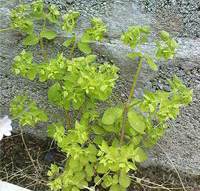
Sap from petty spurge, Euphorbia peplus, appears to treat non-melanoma skin cancers, experts are reporting in the British Journal of Dermatology. The sap has been used for centuries as a traditional medicine, and the researchers wanted to put it through its paces in a proper clinical trial. The study involved 36 who were treated with the sap of the petty spurge plant which was applied to the skin. After a one month trial, 41 of the 48 cancers had shown a complete clinical response to the treatment. NB: not to be tried except under medical supervision. More (Photo by Steve1nova)
Mobile phones increase yields
A new programme in the Philippines allows farmers to use their cell phones to answer a series of questions about their rice fields and then a text is sent back to them giving suggestions on amount of fertiliser to use. The aim is to increase productivity.
Defra consults on forest plans
Defra has announced proposals to transfer heritage forests such as the New Forest and the Forest of Dean to charitable trusts and to lease 'commercial forests' to the private sector. These changes of ownership will allow the Forestry Commission to focus on its key roles of responding to outbreaks of tree pests and diseases, regulating felling and setting standards for sustainable forest management. The proposals would remedy the situation where the Commission is the largest commercial operator in the sector it also regulates. More
Plants to aid airport security?
Scientific research on plants that subtly change colour when exposed to minute amounts of TNT in the air. Plants are uniquely suited by evolution to chemical analysis of their environment. More
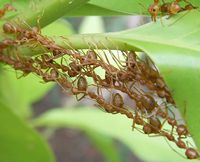
African fruit and nut growers are being trained to use weaver ants to control pests. This form of pest control will reduce losses while opening doors to world organic food markets. The ants used to control pests live in the canopies of a variety of plantation trees. If managed properly, a straightforward operation, they build up to high densities. The ants feed on all kinds of insects in the trees, and destroy or deter a range of different insect pests - in some cases even mammals such as fruit bats because they attack large enemies to protecting their territory against intruders. More (Photo by Sean Hoyland)
Quotes of the Month
'Nothing can be more incorrect than the assumption one sometimes meets with, that physics has one method, chemistry another, and biology a third'.
Thomas Huxley
Events Calendar
Other Events of Interest
UK Vegetable Industry Conference and Exhibition
1 Feb, ADAS / Syngenta UK
Peterborough, UK
Horticulture of Opium Poppy
7 - 11 Feb, International Society for Horticultural Science
Lucknow, India
GAN Trade Show
9 Feb, Golden Acres Nursery
Bournemouth, UK
Interaction of Pesticide Application and Formulation on Residues in Fruit and Vegetables
9 Feb, Association of Applied Biologists
Jealotts Hill, UK
MSP - Martha Schwartz Partners
10 Feb, Oxford Botanic Garden
Oxford, UK
Salon du Vegetal
15 - 17 Feb, UK Pavilion by Commercial Horticultural Association
Angers, France
Grower of the Year Awards
17 Feb, Haymarket Events
London, UK
Crop Protection in Southern Britain
23 Feb, Association of Applied Biologists
Impington, Cambridge, UK
The Woodland Year
24 Feb, Oxford Botanic garden
Oxford, UK
Obstacles, risks and opportunities
2 March, UK Irrigation Association
Peterborough, UK
Ethnobotany
3 Mar, Oxford Botanic Garden
Oxford, UK
Global Conference on Entomology
5 - 9 Mar
Chiang Mai, Thailand
The Trentham Estate: A Contemporary Revival
10 Mar, Oxford Botanic Garden
Oxford, UK
Sustainable Vegetable Production in South East Asia
14 - 17 Mar, International Society for Horticultural Science
Salatiga, Indonesia
New Ag International Conference and Exhibition
15 - 17 Mar, New Ag International
Cairo, Egypt
Wild Relatives of Subtropical and Temperate Fruit and Nut Crops
19 - 23 Mar, International Society for Horticultural Science
Davis, CA, USA
The Icing on the Cake
24 Mar, Oxford Botanic Garden
Oxford, UK
Forests and Global Change
28 - 30 Mar, British Ecological Society
Cambridge, UK
Organic Matter Management and Compost Use in Horticulture
4 - 7 Apr, International Society for Horticultural Science
Adelaide, Australia
Multitrophic Interactions in Soil
4 - 7 Apr, IOBC / WPRS
Cordoba, Spain
Advances in Cider and Fruit Wine Technology
7 Apr, Association of applied Biologists
Pershore, UK
Innovative ideas in pest and weed control in field vegetables
13 Apr, Association of Applied Biologists
Rothamsted, UK
Trees, People and the Built Environment
13 - 14 Apr, Chartered Institute of Foresters
Birmingham, UK
Society of Biology AGM
12 Apr, Society of Biology
London, UK
Systems Approaches to Crop Improvement
14 - 15 Apr, Association of Applied Biologists
Rothamsted, UK
Vegetation Management
27 - 28 Apr, Association of Applied Biologists
Sheffield, UK
If you would like to advertise a forthcoming event please contact zoe.daniel@soci.org
Horticulture Group Contact Details
For submitting ideas or to volunteer to be part of a committee or a group, please contact:
Chairman - Peter Grimbly
Meetings Secretary - Marion Stainton
Minutes Secretary - Margaret Waddy
Newsletter Co-ordinator - Sue Grimbly, E: scihortigroup@btinternet.com
Group Coordinator - Zoe Daniel zoe.daniel@soci.org T: +44 (0)20 7598 1594
